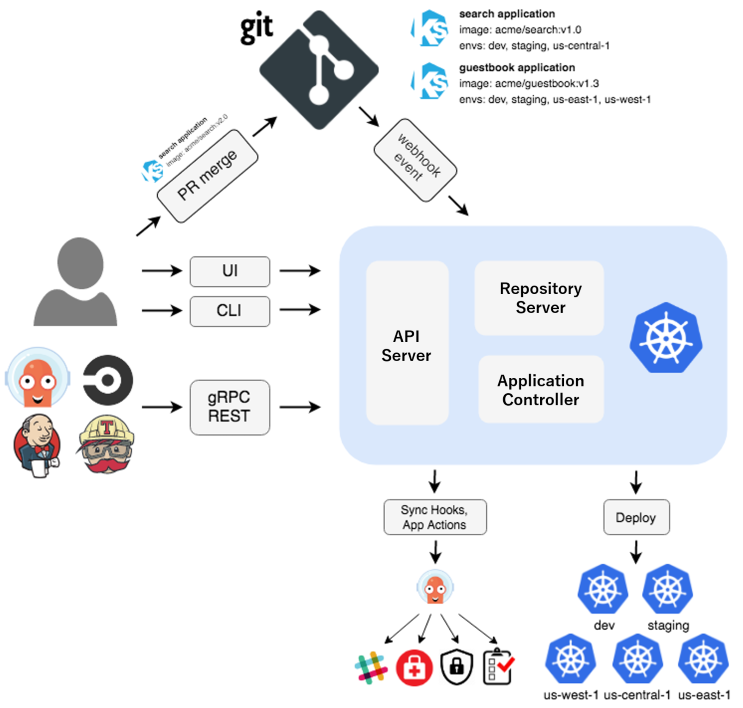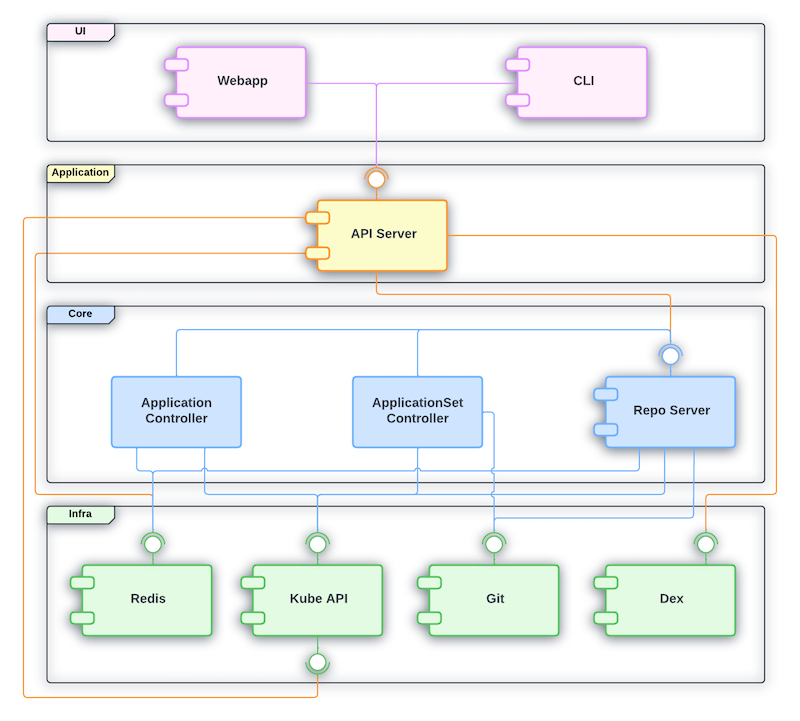5.4 KiB
| title | weight | description |
|---|---|---|
| ArgoCD | 30 | A description of ArgoCD and its role in CNOE |
What is ArgoCD?
ArgoCD is a Continuous Delivery tool for kubernetes based on GitOps principles.
ELI5: ArgoCD is an application running in kubernetes which monitors Git repositories containing some sort of kubernetes manifests and automatically deploys them to some configured kubernetes clusters.
From ArgoCD's perspective, applications are defined as custom resource definitions within the kubernetes clusters that ArgoCD monitors. Such a definition describes a source git repository that contains kubernetes manifests, in the form of a helm chart, kustomize, jsonnet definitions or plain yaml files, as well as a target kubernetes cluster and namespace the manifests should be applied to. Thus, ArgoCD is capable of deploying applications to various (remote) clusters and namespaces.
ArgoCD monitors both the source and the destination. It applies changes from
the git repository that acts as the source of truth for the destination as soon
as they occur, i.e. if a change was pushed to the git repository, the change is
applied to the kubernetes destination by ArgoCD. Subsequently, it checks
whether the desired state was established. For example, it verifies that all
resources were created, enough replicas started, and that all pods are in the
running state and healthy.
Architecture
Core Components
An ArgoCD deployment mainly consists of 3 main components:
Application Controller
The application controller is a kubernetes operator that synchronizes the live state within a kubernetes cluster with the desired state derived from the git sources. It monitors the live state, can detect derivations, and perform corrective actions. Additionally, it can execute hooks on life cycle stages such as pre- and post-sync.
Repository Server
The repository server interacts with git repositories and caches their state, to reduce the amount of polling necessary. Furthermore, it is responsible for generating the kubernetes manifests from the resources within the git repositories, i.e. executing helm or jsonnet templates.
API Server
The API Server is a REST/gRPC Service that allows the Web UI and CLI, as well as other API clients, to interact with the system. It also acts as the callback for webhooks particularly from Git repository platforms such as GitHub or Gitlab to reduce repository polling.
Others
The system primarily stores its configuration as kubernetes resources. Thus, other external storage is not vital.
- Redis
- A Redis store is optional but recommended to be used as a cache to reduce load on ArgoCD components and connected systems, e.g. git repositories.
- ApplicationSetController
- The ApplicationSet Controller is similar to the Application Controller a kubernetes operator that can deploy applications based on parameterized application templates. This allows the deployment of different versions of an application into various environments from a single template.
Overview
Role in CNOE
ArgoCD is one of the core components besides gitea/forgejo that is being bootstrapped by the idpbuilder. Future project creation, e.g. through backstage, relies on the availability of ArgoCD.
After the initial bootstrapping phase, effectively all components in the stack that are deployed in kubernetes are managed by ArgoCD. This includes the bootstrapped components of gitea and ArgoCD which are onboarded afterward. Thus, the idpbuilder is only necessary in the bootstrapping phase of the platform and the technical coordination of all components shifts to ArgoCD eventually.
In general, the creation of new projects and applications should take place in backstop. It is a catalog of software components and best practices that allows developers to grasp and to manage their software portfolio. Underneath, however, the deployment of applications and platform components is managed by ArgoCD. Among others, backstage creates Application CRDs to instruct ArgoCD to manage deployments and subsequently report on their current state.
Glossary
Initially shamelessly copied from the docs
- Application
- A group of Kubernetes resources as defined by a manifest. This is a Custom Resource Definition (CRD).
- ApplicationSet
- A CRD that is a template that can create multiple parameterized Applications.
- Application source type
- Which Tool is used to build the application.
- Configuration management tool
- See Tool.
- Configuration management plugin
- A custom tool.
- Health
- The health of the application, is it running correctly? Can it serve requests?
- Live state
- The live state of that application. What pods etc are deployed.
- Refresh
- Compare the latest code in Git with the live state. Figure out what is different.
- Sync
- The process of making an application move to its target state. E.g. by applying changes to a Kubernetes cluster.
- Sync status
- Whether or not the live state matches the target state. Is the deployed application the same as Git says it should be?
- Sync operation status
- Whether or not a sync succeeded.
- Target state
- The desired state of an application, as represented by files in a Git repository.
- Tool
- A tool to create manifests from a directory of files. E.g. Kustomize. See Application Source Type.

